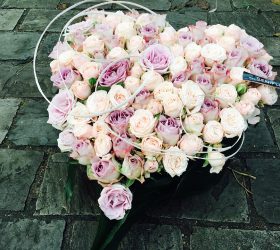Customs differ based on the religion or ethnicity of the family, but funeral flowers or basket gardens are often delivered to the funeral home, the church or the bereaved family’s residence. To be more accurate, flowers sent to the family’s home are technically sympathy flowers. In either case, be certain to include your first and last name on the card that is sent with the floral arrangement. Even for funerals prior to cremation in Tallahassee, FL and other areas, flowers are often a lovely respite during a somber event. You should respect the family’s wishes if the obituary specifically requests that charitable donations be made instead of sending flowers.
Historically, flowers have been used to represent growth, new life and moving forward. Funeral flowers bring an element of natural beauty, decoration, fragrance, warmth and comfort to the funeral and the home of the mourning family. Florals sent to the funeral home pay tribute to the deceased. In modern day, such blossoms are not required but they remain a way for friends and relatives to demonstrate their love of the departed and their condolences to the close members of his or her family. You can order the flowers from a florist to be sent to the funeral parlor or family home.
Funeral flowers should be scheduled to arrive at the funeral home prior to the first hours of the visitation so as to be present when the family gets there. If you do not have enough time to accomplish this, you can send the flowers or a plant to the home of the grieving family. A potted plant is an enduring reminder of your kindness, and symbolizes how the loved one will live on and continue to grow.
Funeral flowers are typically categorized by functionality. The following are several of the more frequently utilized arrangements to facilitate clarity when ordering:
1. Wreaths are circular floral arrangements that represent perpetual life.
2. Floral arrangements range from fresh cut flowers to basket and container bouquets.
3. Sprays are arrangements that permit viewing from only one side.
4. Casket sprays are placed atop the coffin and are usually purchased by the immediate family. 5. Inside pieces are put inside the casket, such as a small floral spray.
Please keep in mind that although flowers are often gracefully accepted by many families, some religions, such as Judaism and Islam, have traditionally not welcomed them at funerals. According to Jewish law, burial of the deceased is required within three days, so flowers were never needed. It is still not the norm to send flowers to a Jewish funeral, though it is not prohibited, and some Jews do send them to Reformed Jewish funerals. It is more common to send fruit and food baskets to the bereaved during the period of mourning. For Muslim funerals, sending flowers is a personal choice. Many place single blooms, palm branches and other greenery on graves. Hindu funerals do not traditionally include flowers, but they are not forbidden. You should not send red flowers to a Buddhist funeral; opt instead for yellow or white ones.
In general, though, there are not specific types or colors of flowers that are appropriate to be sent to those in mourning or to the funeral home. Carnations, snapdragons, chrysanthemums, gladiolas, lilies and roses are popular choices in funeral flower arrangements. White lilies stand for peace and red roses are famously emblematic of love. If the deceased was known to have a favorite bloom, sending it in an arrangement will surely be a comfort to the bereaved.
